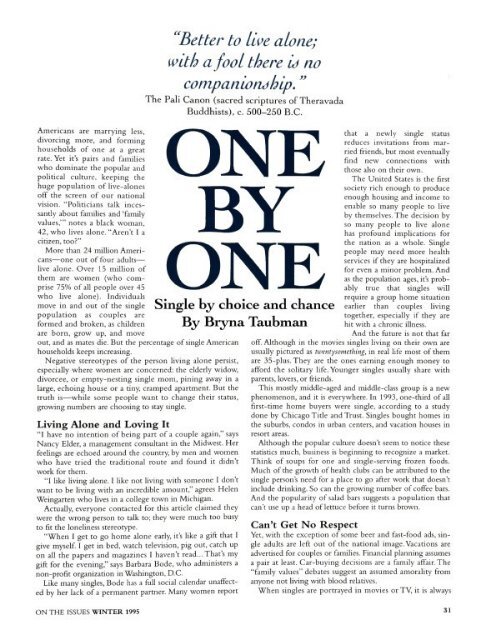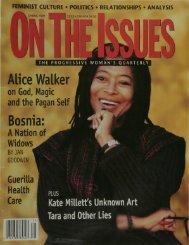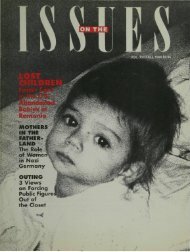view entire issue in pdf format - On The Issues Magazine
view entire issue in pdf format - On The Issues Magazine
view entire issue in pdf format - On The Issues Magazine
You also want an ePaper? Increase the reach of your titles
YUMPU automatically turns print PDFs into web optimized ePapers that Google loves.
Americans are marry<strong>in</strong>g less,<br />
divorc<strong>in</strong>g more, and form<strong>in</strong>g<br />
households of one at a great<br />
rate. Yet it's pairs and families<br />
who dom<strong>in</strong>ate the popular and<br />
political culture, keep<strong>in</strong>g the<br />
huge population of live-alones<br />
off the screen of our national<br />
vision. "Politicians talk <strong>in</strong>cessantly<br />
about families and 'family<br />
values,'" notes a black woman,<br />
42, who lives alone. "Aren't I a<br />
citizen, too"<br />
More than 24 million Americans—one<br />
out of four adults—<br />
live alone. Over 15 million of<br />
them are women (who comprise<br />
75% of all people over 45<br />
who live alone). Individuals<br />
move <strong>in</strong> and out of the s<strong>in</strong>gle<br />
population as couples are<br />
formed and broken, as children<br />
are born, grow up, and move<br />
out, and as mates die. But the percentage of s<strong>in</strong>gle American<br />
households keeps <strong>in</strong>creas<strong>in</strong>g.<br />
Negative stereotypes of the person liv<strong>in</strong>g alone persist,<br />
especially where women are concerned: the elderly widow,<br />
divorcee, or empty-nest<strong>in</strong>g s<strong>in</strong>gle mom, p<strong>in</strong><strong>in</strong>g away <strong>in</strong> a<br />
large, echo<strong>in</strong>g house or a t<strong>in</strong>y, cramped apartment. But the<br />
truth is—while some people want to change their status,<br />
grow<strong>in</strong>g numbers are choos<strong>in</strong>g to stay s<strong>in</strong>gle.<br />
Liv<strong>in</strong>g Alone and Lov<strong>in</strong>g It<br />
"I have no <strong>in</strong>tention of be<strong>in</strong>g part of a couple aga<strong>in</strong>," says<br />
Nancy Elder, a management consultant <strong>in</strong> the Midwest. Her<br />
feel<strong>in</strong>gs are echoed around the country, by men and women<br />
who have tried the traditional route and found it didn't<br />
work for them.<br />
"I like liv<strong>in</strong>g alone. I like not liv<strong>in</strong>g with someone I don't<br />
want to be liv<strong>in</strong>g with an <strong>in</strong>credible amount," agrees Helen<br />
We<strong>in</strong>garten who lives <strong>in</strong> a college town <strong>in</strong> Michigan.<br />
Actually, everyone contacted for this article claimed they<br />
were the wrong person to talk to; they were much too busy<br />
to fit the lonel<strong>in</strong>ess stereotype.<br />
"When I get to go home alone early, it's like a gift that I<br />
give myself. I get <strong>in</strong> bed, watch television, pig out, catch up<br />
on all the papers and magaz<strong>in</strong>es I haven't read...That's my<br />
gift for the even<strong>in</strong>g," says Barbara Bode, who adm<strong>in</strong>isters a<br />
non-profit organization <strong>in</strong> Wash<strong>in</strong>gton, D.C.<br />
Like many s<strong>in</strong>gles, Bode has a full social calendar unaffected<br />
by her lack of a permanent partner. Many women report<br />
Better to live alone;<br />
with afoot there id no<br />
companionship.'<br />
<strong>The</strong> Pali Canon (sacred scriptures of <strong>The</strong>ravada<br />
Buddhists), c. 500-250 B.C.<br />
ONE<br />
BY<br />
ONE<br />
S<strong>in</strong>gle by choice and chance<br />
By Bryna Taubman<br />
that a newly s<strong>in</strong>gle status<br />
reduces <strong>in</strong>vitations from married<br />
friends, but most eventually<br />
f<strong>in</strong>d new connections with<br />
those also on their own.<br />
<strong>The</strong> United States is the first<br />
society rich enough to produce<br />
enough hous<strong>in</strong>g and <strong>in</strong>come to<br />
enable so many people to live<br />
by themselves. <strong>The</strong> decision by<br />
so many people to live alone<br />
has profound implications for<br />
the nation as a whole. S<strong>in</strong>gle<br />
people may need more health<br />
services if they are hospitalized<br />
for even a m<strong>in</strong>or problem. And<br />
as the population ages, it's probably<br />
true that s<strong>in</strong>gles will<br />
require a group home situation<br />
earlier than couples liv<strong>in</strong>g<br />
together, especially if they are<br />
hit with a chronic illness.<br />
And the future is not that far<br />
off. Although <strong>in</strong> the movies s<strong>in</strong>gles liv<strong>in</strong>g on their own are<br />
usually pictured as twenty someth<strong>in</strong>g, <strong>in</strong> real life most of them<br />
are 35-plus. <strong>The</strong>y are the ones earn<strong>in</strong>g enough money to<br />
afford the solitary life. Younger s<strong>in</strong>gles usually share with<br />
parents, lovers, or friends.<br />
This mostly middle-aged and middle-class group is a new<br />
phenomenon, and it is everywhere. In 1993, one-third of all<br />
first-time home buyers were s<strong>in</strong>gle, accord<strong>in</strong>g to a study<br />
done by Chicago Title and Trust. S<strong>in</strong>gles bought homes <strong>in</strong><br />
the suburbs, condos <strong>in</strong> urban centers, and vacation houses <strong>in</strong><br />
resort areas.<br />
Although the popular culture doesn't seem to notice these<br />
statistics much, bus<strong>in</strong>ess is beg<strong>in</strong>n<strong>in</strong>g to recognize a market.<br />
Th<strong>in</strong>k of soups for one and s<strong>in</strong>gle-serv<strong>in</strong>g frozen foods.<br />
Much of the growth of health clubs can be attributed to the<br />
s<strong>in</strong>gle person's need for a place to go after work that doesn't<br />
<strong>in</strong>clude dr<strong>in</strong>k<strong>in</strong>g. So can the grow<strong>in</strong>g number of coffee bars.<br />
And the popularity of salad bars suggests a population that<br />
can't use up a head of lettuce before it turns brown.<br />
Can't Get No Respect<br />
Yet, with the exception of some beer and fast-food ads, s<strong>in</strong>gle<br />
adults are left out of the national image. Vacations are<br />
advertised for couples or families. F<strong>in</strong>ancial plann<strong>in</strong>g assumes<br />
a pair at least. Car-buy<strong>in</strong>g decisions are a family affair. <strong>The</strong><br />
"family values" debates suggest an assumed amorality from<br />
anyone not liv<strong>in</strong>g with blood relatives.<br />
When s<strong>in</strong>gles are portrayed <strong>in</strong> movies or TV, it is always<br />
ON THE ISSUES WINTER 1995<br />
31

















